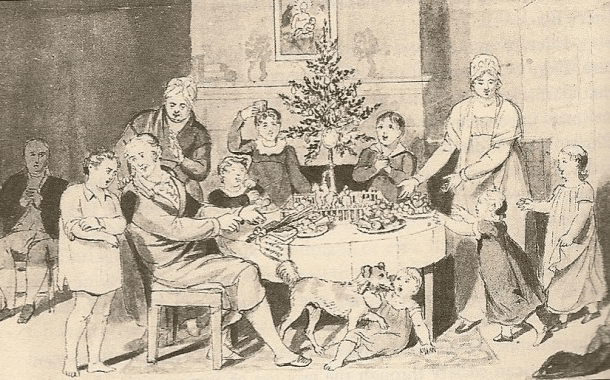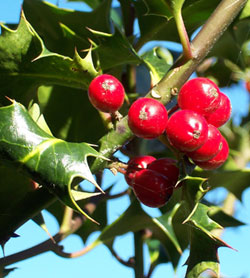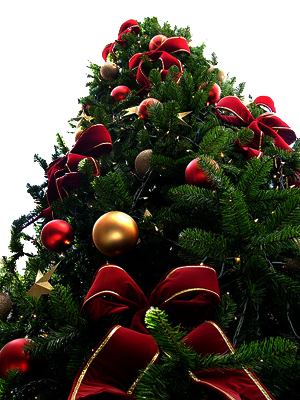Christmas Greenery
by Roger Kaza
Today, Christmas greenery. The University of Houston presents this program about the machines that make our civilization run, and the people whose ingenuity created them.
Did you get your Christmas tree yet? Just the right size? It's an ongoing concern. An Alsatian forest ordinance from 1561 states that citizens are allowed one tree, no more than 'eight shoes' in length. Undoubtedly the largest-footed member of the household did the shopping, I mean chopping. Germans loved their evergreens, and they finally convinced us to love them too. But our colonial forbearers were torn enough about celebrating Christmas at all, much less with decorated trees. So Christmas trees didn't come to America until the first wave of German immigrants arrived in the early part of the 19th century.

Thank them as well, for the lights on the tree. The story goes that Martin Luther was walking home one cold winter night, composing his Sunday sermon. The brilliant stars twinkling through the forest grabbed his attention, and when he got home he wired candles to the Christmas tree to recreate the effect. We've just updated things a bit with electric bulbs, now LEDs.
But let's back up even further. What's the connection of trees to Christmas to begin with? One legend concerns an English monk, St. Boniface, preaching to Germanic Druids in the 8th century. They already had a sacred tree, the oak. To provoke things, the evangelist chopped one down right then and there. It crashed to the ground, trampling everything in its path — except one small evergreen sapling. St. Boniface continued his preaching, using the invincible baby fir tree to represent the Christ child. A tradition was born, and trees were planted across the land'so the story goes.
 Are your halls decked with holly? Holly joined the festivities as a pinch-hitter. The Druids also revered mistletoe, and used it in their rituals. The Scandinavians associated it with the goddess Frigga, for whom we name our favorite day of the week. What does all this have to do with holly? The church thought holly made a much better Christmas symbol than mistletoe. Its thorny leaves recall Jesus' crown of thorns on the cross, and the tiny red berries, drops of blood.
Are your halls decked with holly? Holly joined the festivities as a pinch-hitter. The Druids also revered mistletoe, and used it in their rituals. The Scandinavians associated it with the goddess Frigga, for whom we name our favorite day of the week. What does all this have to do with holly? The church thought holly made a much better Christmas symbol than mistletoe. Its thorny leaves recall Jesus' crown of thorns on the cross, and the tiny red berries, drops of blood.
We can't have holly without ivy. What's that all about? Well, again, think botanically. Ivy has heart-shaped leaves, and tendrils that cling lovingly to anything in their path. Could there be a better emblem of the virtue of charity? Most colleges started with a religious affiliation, so maybe that's their ivy connection as well.
All this greenery, grafted to spiritual roots. Are there any newcomers in the garden? Well, relatively speaking, maybe: poinsettias. The Aztecs made dye from their leaves, and Franciscan friars in Mexico incorporated them into Christmas in the 17th century. They have no ancient tradition; they're just beautiful. And may your holidays be beautiful — and green — this Christmas season.
I'm Roger Kaza, from the University of Houston, where we're interested in the way inventive minds work.
Much of the above article is 'lore' and cannot be verified in a completely historical sense.  The factual information comes primarily from Charles Panati's book, Extraordinary Origins of Ordinary Things. (Harpers, 1989) Google searches on any of the above greenery will produce a wide variety of explanations as to their history, significance, and ritual usage.
The factual information comes primarily from Charles Panati's book, Extraordinary Origins of Ordinary Things. (Harpers, 1989) Google searches on any of the above greenery will produce a wide variety of explanations as to their history, significance, and ritual usage.
The Norse goddess Frige or Frigg (anglicized to Frigga) is also linked to the planet Venus, hence an association of mistletoe with kissing. See as well Engines No. 770 for another connection.
An interesting examination of superstitions relating to Christmas greenery from Snopes.com.
The black and white image is the first printed image of an American Christmas tree occurred in 1836. It appeared in The Stranger's Gift written by Herman Bokum. All other images are in Creative Commons.